Adventures of a B-24 Navigator
Use controls above or click here to open this Hometown Heroes podcast in a new window
99-year-old Leonard Lonigan of Falls City, OR appears on episode #647 of Hometown Heroes, airing September 26 – October 1, 2020. A native of Grants Pass, OR, Lonigan completed 35 missions as a navigator on B-24s with the 734th Squadron, 453rd Bomb Group during World War II.
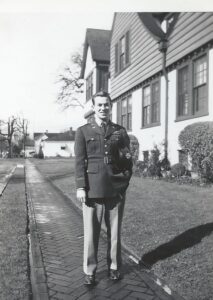
Leonard Lonigan in 1944. For more photos, visit the Hometown Heroes facebook page.
Much of his early years were spent working, with his older brother, Bill, in their father’s meat market. Leonard competed in wrestling and tennis and had ambitions of someday pursuing coaching as a career. Listen to Hometown Heroes to find out how World War II redirected those plans, and how he received word of the Japanese attack on Pearl Harbor on December 7, 1941. His brother had been in the Army Air Corps for more than a year at that point, and Leonard would also choose that avenue of military service, enlisting in March, 1943.
“We had a big thing that had to be done,” you’ll hear him say, referring to the urgent task of defeating tyranny in WWII. “There was no need to worry about anything else, because if that’s not done, there’s not going to be anything to worry about.”
After training in San Antonio and Houston, TX, he was assigned as navigator in the ten-man crew of a B-24 Liberator at Peterson Field in Colorado Springs, CO. That’s where he was on June 6, 1944, and you’ll hear his memory of the unique way he learned about the Normandy landings. 18 days later, on his 23rd birthday, he headed overseas aboard the RMS Queen Elizabeth. Providing entertainment for that cross-Atlantic journey were members of the Glenn Miller Army Air Forces Orchestra, including Tex Beneke and Johnny Desmond. After landing in Glasgow, Scotland, he spent some time in England before heading to Northern Ireland for a month of training in identifying enemy aircraft and handling potential situations they might encounter. If all went as planned, his job of navigation would be pretty uneventful, with the lead plane in each formation setting a path to follow.
“The only reason they needed a navigator is if you got shot out of formation,” he says of a typical 8th Air Force bomber. “Then you had to be able to bring them home.”
The 453rd Bomb Group was headquartered at RAF Old Buckenham near Norwich in East Anglia, England. If you visit the airfield today, you’ll find a museum, as well as a cafe named in honor of the most famous American to serve there during the war, Jimmy Stewart. The well-known actor flew 20 combat missions as a bomber pilot and was awarded the Distinguished Flying Cross. He finished up a stint as Operations Officer for the 453rd at “Old Buc” just as Leonard Lonigan was arriving. You’ll hear Lonigan’s perspective on Stewart, as well as why the navigator’s first mission was a rude awakening to the reality of war, not to mention high altitude bombing.
“The first two planes in front of us went down,” you’ll hear him say of July 31, 1944. “Most of the crew was really shook by that. I was not because I was throwing up.”
Lonigan wasn’t the only member of the crew to to feel the effects of extreme altitude. Over time, he would grow accustomed to it, and he would also encounter situations where his role as navigator became paramount to the crew’s survival. You’ll hear him remember one such mission targeting Nazi facilities in Dessau, Germany, 100 miles southwest of Berlin.
“It’s amazing to drop your bombs amidst a sky that is just completely black with gunpowder,” you’ll hear Lonigan describe. “Come out of the powder, see that you’ve got an engine missing, and realize that the other 36 planes have disappeared.”
The bombers had been instructed to follow railroad tracks into Dessau and the target of their bombing missions. The hiccup in that plan came when they realized that the enemy had placed a wealth of 88mm anti-aircraft guns on top of flat cars on the railroad tracks. Soon a wall of flak materialized between the B-24s and the target area. As the damaged B-24 emerged, alone, after dropping its bombs, it became Lonigan’s duty to chart a path to safety, hoping to dodge heavily populated cities and fly back out of German-held territory. Just as the plane reached the coastline, ready to cross the English Channel, anti-aircraft fire again came billowing up toward the B-24’s altitude. You’ll hear Lonigan explain why there was only one “safe” direction for the lone Liberator to go, and what happened as the flak gun appeared to zero in on their location.
“Right in front of us is a puff. I would say 15 seconds until the next one,” you’ll hear him recall of those anxious moments. “In that time, a P-51 flew down and took out the gun.”
That Mustang’s intervention saved Lonigan’s plane and allowed the B-24 to cross safely across the channel. After landing, Leonard and two fellow officers took a train up to Norwich to enjoy tea and cookies at the Red Cross outpost. While there, they overheard a fighter pilot relating the flight from which he had just returned, eliminating an anti-aircraft gun to save a B-24. Listen to Hometown Heroes for Leonard’s memories of that “small world” moment with the man whose actions had spared their crew. When Lonigan first arrived in England, 25 missions would be sufficient to complete a crew’s combat tour. He had 12 under his belt when that threshold was moved to 35 for anyone who had not yet reached 15 missions. His 23rd mission on October 17, 1944 would prove to be the most memorable, as well as the most harrowing. Flying in the B-24 “Lucky Penny II,” the crew bombed railroad marshalling yards in Cologne, Germany. Enemy forces had figured out a way to mimic smoke bombs that would mark the target for a flight of bombers. By the time the pilot realized the smoke rising from the ground was a German decoy, the bombardier had already released one of his bombs, the one in the left front position. Had that bomb still been in place, what happened 15 seconds later may have cost ten men their lives.
“An 88-millimeter comes up, through the top of the plane, and explodes above us,” you’ll hear Leonard explain. “No harm, particularly, except it went through the main gas line.”
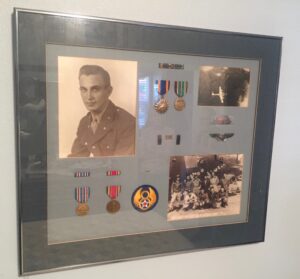
Above the 8th Air Force patch in this display is a small caterpillar pin, signifying Leonard’s parachuting from his B-24. For more, watch the video below.
That damage slowed the plane down considerably, and Leonard again found himself tasked with trying to guide a lone, limping bomber back to safety. Read this dramatic account of that mission from Wilbur Stites, the left waist gunner, and listen to Hometown Heroes for Leonard Lonigan’s memories of how it all unfolded. After following the Rhine River south from Cologne to Koblenz, Lonigan plotted a westward course, not knowing how close they were to territory held by the Allied forces on the ground. The first time they descended through the overcast, they saw nothing but German tanks and realized they were right above the Siegfried Line. As incoming fire – thankfully inaccurate – roared past the B-24, pilot William Lofton was able to climb back up through the clouds, continuing to the west. About five minutes later, they came down through the clouds again and Lonigan surveyed the landscape.
“I got lucky, I recognized a Belgian flag,” you’ll hear him recall. “I says, ‘We’re behind the lines,’ and he hit bail out.”
As the navigator, Lonigan was the first to exit the nose of the plane. You’ll hear his memories of procedures he had never experienced or practiced before. Reuniting with members of his crew after touching down, he was actually able to go inspect the wreckage of their B-24. Lonigan estimates the bomber might have flown another 60 to 90 seconds before running completely out of fuel.
The next day, they were driven to Brussels, then flown from that bombed out airfield back home to Old Buckenham. You’ll Lonigan share memories from other missions as well, including the time his crewmates jokingly suggested he should be awarded the Purple Heart, as well as how he was credited with helping to save eight Royal Air Force pilots. He says he “went out and kissed the ground” after touching down at the end of his 35th and final mission. He required hernia surgery when he returned to the United States, a result of the jolt he experienced at the end of his parachute jump months earlier. By the time Germany surrendered to the Allies on May 8, 1945, Lonigan had made it to Selman Field in Monroe, LA to serve as an instructor in the Army Air Corps’ premier navigation school. After his discharge, Leonard employed his benefits from the G.I. Bill to finish his schooling at the University of Oregon. Eugene is where he would spend most of his life, including the 62 years of marriage he enjoyed with his sweetheart, Marjorie. Leonard’s affinity for his alma mater’s sports teams continues as he approaches his 100th birthday, and for 35 years he served as the official scorer for the Ducks’ famed men’s track & field team under Hall of Fame coach Bill Bowerman. Every American or world record that legendary distance runner Steve Prefontaine eclipsed at Hayward Field was officially confirmed and recorded by Leonard Lonigan. His proximity to the program also presented the opportunity to become an early investor in an athletic shoe startup launched by a former Oregon miler. Leonard didn’t have the wherewithal to buy in, but he has enjoyed watching what Phil Knight’s brainchild has turned into, and the impact Nike has had at the University of Oregon and elsewhere. Reflecting on nearly a century of life, he says he’s most thankful for his family, and recognizes how fortunate he is to have persevered through some of the dangerous circumstances he faced.
“There are plenty of things that happen day by day that could just as easily have gone the other way,” Lonigan explains. “I’ve always felt that I’ve been very well blessed.”
Thanks to listener (on affiliate KYKN) Steve Roby from Bridgeport Community Chapel for letting us know about Mr. Lonigan, who has become known as “The Gummi Bear Man” in that congregation. You’ll hear Leonard explain how a few candies for his great-grandchildren turned into as many as 40 bags per Sunday. You’ll also hear about his 2015 journey to the National World War II Memorial in Washington, D.C. with Honor Flight of Oregon, accompanied by his daughter, Kay. You’ll hear Leonard remember his friend from Grants Pass, Bobby Coons, who was killed in the Philippines while serving with the 41st Infantry Division in 1944. Coons and more than 406,000 other Americans paid a price for our freedom that this 99-year-old hopes we won’t take for granted. You’ll hear him express his desire that the U.S. in 2020 can learn from the example of a truly “United” States in World War II, when political differences did not prove insurmountable.
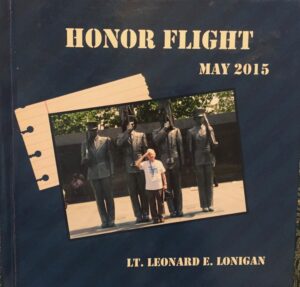
The cover of this Honor Flight memory book crafted by Leonard’s daughter shows him saluting at the U.S. Air Force Memorial
“I look at our society today, and it scares me. It scares me for my grandchildren and great-grandchildren,” Lonigan says. “We had two different parties back there that disagreed, but we didn’t hate each other, and this hatred is killing us.”
You’ll hear similar statements in the short video below, including the closing thought that “this is a time where it would be awfully nice if we could get together.”
—Paul Loeffler

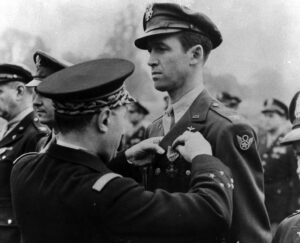
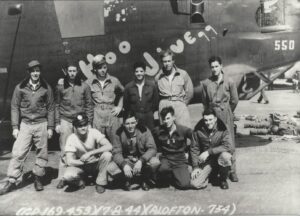
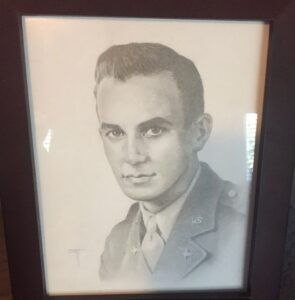
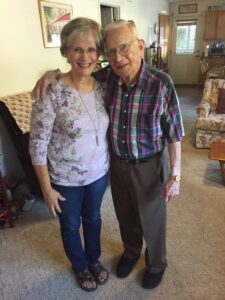
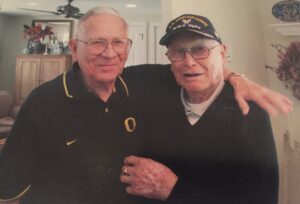

Amazing story, amazing man.